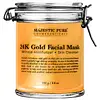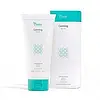What's inside
What's inside
 Key Ingredients
Key Ingredients

 Benefits
Benefits

 Concerns
Concerns

 Ingredients Side-by-side
Ingredients Side-by-side

Water
Skin ConditioningButoxyethanol
MaskingSilk Amino Acids
HumectantCeramide AP
Skin ConditioningCodium Tomentosum Extract
Skin ProtectingHydrolyzed Collagen
EmollientLeontopodium Alpinum Extract
Skin ConditioningCentella Asiatica Extract
CleansingBeta-Glucan
Skin ConditioningPortulaca Oleracea Extract
Skin ConditioningButyrospermum Parkii Butter
Skin ConditioningCereus Grandiflorus Extract
AntioxidantArnica Montana Flower Extract
MaskingSodium Hyaluronate
HumectantPolyglutamic Acid
Skin ConditioningTocopherol
AntioxidantXanthan Gum
EmulsifyingAllantoin
Skin ConditioningGold
Cosmetic ColorantWater, Butoxyethanol, Silk Amino Acids, Ceramide AP, Codium Tomentosum Extract, Hydrolyzed Collagen, Leontopodium Alpinum Extract, Centella Asiatica Extract, Beta-Glucan, Portulaca Oleracea Extract, Butyrospermum Parkii Butter, Cereus Grandiflorus Extract, Arnica Montana Flower Extract, Sodium Hyaluronate, Polyglutamic Acid, Tocopherol, Xanthan Gum, Allantoin, Gold
Water
Skin ConditioningGlycerin
HumectantPentylene Glycol
Skin ConditioningOlus Oil
EmollientGlyceryl Stearate Citrate
EmollientButyrospermum Parkii Butter
Skin ConditioningDecyl Oleate
EmollientKaolin
AbrasivePrunus Amygdalus Dulcis Oil
Skin ConditioningSimmondsia Chinensis Seed Oil
EmollientCetearyl Alcohol
EmollientBehenyl Alcohol
EmollientAvena Sativa Kernel Flour
AbrasiveBeta-Glucan
Skin ConditioningTocopherol
AntioxidantCeramide NP
Skin ConditioningAllantoin
Skin ConditioningPectin
Emulsion StabilisingPanthenol
Skin ConditioningDaucus Carota Sativa Root Extract
Skin ConditioningSodium Hyaluronate
HumectantCitric Acid
BufferingHelianthus Annuus Seed Oil
EmollientCaprylic/Capric Triglyceride
MaskingHydrogenated Phosphatidylcholine
EmulsifyingSqualane
EmollientWater, Glycerin, Pentylene Glycol, Olus Oil, Glyceryl Stearate Citrate, Butyrospermum Parkii Butter, Decyl Oleate, Kaolin, Prunus Amygdalus Dulcis Oil, Simmondsia Chinensis Seed Oil, Cetearyl Alcohol, Behenyl Alcohol, Avena Sativa Kernel Flour, Beta-Glucan, Tocopherol, Ceramide NP, Allantoin, Pectin, Panthenol, Daucus Carota Sativa Root Extract, Sodium Hyaluronate, Citric Acid, Helianthus Annuus Seed Oil, Caprylic/Capric Triglyceride, Hydrogenated Phosphatidylcholine, Squalane
Alternatives
Ingredients Explained
These ingredients are found in both products.
Ingredients higher up in an ingredient list are typically present in a larger amount.
Allantoin is a soothing ingredient known for its protective and moisturizingg properties. Because of this, it is often added to products with strong active ingredients.
Studies show higher concentrations of this ingredient can promote wound healing.
Though it can be derived from the comfrey plant, allantoin is produced synthetically for cosmetic products to ensure purity.
Learn more about AllantoinBeta-Glucan is a polysaccharide. It can be derived from the cell walls of seaweed, oats, yeast, and fungi. It hydrates the skin and helps boost your skin's natural barrier.
As an antioxidant, beta-glucan helps fight free-radicals. Free-radicals are molecules that may damage your skin cells, such as pollution.
Studies show this ingredient may be an effective wrinkle reducer as it can deeply penetrate into skin. It has also been show to help with wound healing.
Learn more about Beta-GlucanThis ingredient is also known as shea butter. It is an effective skin hydrator and emollient.
Emollients help soothe and soften your skin. It does this by creating a protective film on your skin. This barrier helps trap moisture and keeps your skin hydrated. Emollients may be effective at treating dry or itchy skin.
Shea butter is rich in antioxidants. Antioxidants help fight free-radicals, or molecules that may harm the body. It is also full of fatty acids including stearic acid and linoleic acid. These acids help replenish the skin and keep skin moisturized.
While Shea Butter has an SPF rating of about 3-4, it is not a sunscreen replacement.
Shea butter may not be fungal acne safe. We recommend speaking with a professional if you have any concerns.
Learn more about Butyrospermum Parkii ButterSodium Hyaluronate is hyaluronic acid's salt form. It is commonly derived from the sodium salt of hyaluronic acid.
Like hyaluronic acid, it is great at holding water and acts as a humectant. This makes it a great skin hydrating ingredient.
Sodium Hyaluronate is naturally occurring in our bodies and is mostly found in eye fluid and joints.
These are some other common types of Hyaluronic Acid:
Learn more about Sodium HyaluronateTocopherol (also known as Vitamin E) is a common antioxidant used to help protect the skin from free-radicals and strengthen the skin barrier. It's also fat soluble - this means our skin is great at absorbing it.
Vitamin E also helps keep your natural skin lipids healthy. Your lipid skin barrier naturally consists of lipids, ceramides, and fatty acids. Vitamin E offers extra protection for your skin’s lipid barrier, keeping your skin healthy and nourished.
Another benefit is a bit of UV protection. Vitamin E helps reduce the damage caused by UVB rays. (It should not replace your sunscreen). Combining it with Vitamin C can decrease sunburned cells and hyperpigmentation after UV exposure.
You might have noticed Vitamin E + C often paired together. This is because it is great at stabilizing Vitamin C. Using the two together helps increase the effectiveness of both ingredients.
There are often claims that Vitamin E can reduce/prevent scarring, but these claims haven't been confirmed by scientific research.
Learn more about TocopherolWater. It's the most common cosmetic ingredient of all. You'll usually see it at the top of ingredient lists, meaning that it makes up the largest part of the product.
So why is it so popular? Water most often acts as a solvent - this means that it helps dissolve other ingredients into the formulation.
You'll also recognize water as that liquid we all need to stay alive. If you see this, drink a glass of water. Stay hydrated!
Learn more about Water